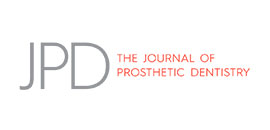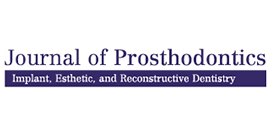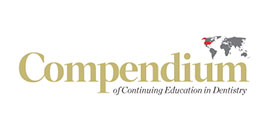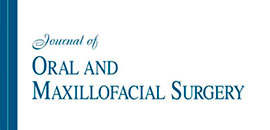
Minimizing the discrepancy between implant platform and alveolar bone for tilted implants with a sloped implant platform
Dr. Fernando Rojas-Vizcaya, Dr. Homa Zadeh
The Journal of Prosthetic Dentistry
junio de 2017
In a patient with edentulism, distally tilted implants with a novel sloped implant platform were used to minimize the discrepancy between the implant platform and alveolar bone crest and to restore complete-arch monolithic zirconia implant-supported fixed prostheses. (J Prosthet Dent 2017).

Prosthetically Guided Bone Sculpturing for a Maxillary Complete-Arch Implant-Supported Monolithic Zirconia Fixed Prosthesis Based on a Digital Smile Design: A clinical Report.
Rojas-Vizcaya, Fernando, DDS, MS
Journal of Prosthetic Dentistry
2017 February
A digital smile design was used to create an average smile and to develop a removable interim restoration for an edentulous patient with a high smile line and different bone levels in the maxilla. The interim restoration was used as a guide to perform bone sculpturing to create space for the biological width and to restore a monolithic zirconia implant-supported fixed restoration.

Retrospective 2- to 7-Year Follow-Up Study of 20 Double Full-Arch Implant-Supported Monolithic Zirconia Fixed Prostheses: Measurements and Recommendations for Optimal Design
Rojas-Vizcaya, Fernando, DDS, MS
Journal of Prosthodontics
2016 Aug 29. doi: 10.1111/jopr.12528
To measure the extension of cantilever lengths, thicknesses, and heights of zirconia prostheses in the lingual and facial areas of the distal screw access openings, and to evaluate the clinical performance regarding chipping or fracture of the distal cantilevered sections of double full-arch CAD/CAM screw-retained, stained, monolithic zirconia, gingival-colored ceramic implant-supported fixed prostheses (MZ-FPs).

Biological Aspects as a Rule for Single Implant Placement. The 3A-2B Rule: A Clinical Report
Rojas-Vizcaya, Fernando, DDS, MS
Journal of Prosthodontics
2013 Oct;22(7):575-80
For an implant restoration to be both esthetically and functionally successful, the prosthodontist must conduct a thorough treatment plan and complete a prosthesis design. The prosthodontist must carefully calculate the space needed for the restoration and soft tissue in the restoration process. The restoration and soft tissue are affected by the three-dimensional (3D) position of the implant, as the implant’s depth determines the ideal length of the crown. When determining the 3D position of the implant, the clinician must consider the biological aspects required to ensure the restoration’s biological integration with the patient’s hard and soft tissues. The restoration must be the first component considered in the treatment plan. In addition, the clinician must understand that the distance between the cervical contour (of the planned restoration) and the level of the bone will dictate how the surgical and prosthetic treatment plan is enacted. In this report, a novel Radiographic Biological Ruler© (with biological information) was used to help facilitate the treatment plan’s analysis.

Rehabilitation of the maxillary arch with implant-supported fixed restorations guided by the Most Apical Buccal Bone Level in the esthetic zone: a clinical report
Rojas-Vizcaya, Fernando, DDS, MS
The Journal of Prosthetic Dentistry
2012 April ;107(4):213-20
This article describes a prosthetically-driven protocol for the rehabilitation of the completely edentulous maxillary arch using immediate implant placement and loading techniques. After the incisal edges of the planned maxillary central incisors are determined, the most apical buccal bone level in the esthetic zone serves to guide complete arch rehabilitation.
AWARD: Judson C. Hickey Scientific Writing Award – The Journal of Prosthetic Dentistry
Award for Best Clinical Category:
The prize was awarded to Fernando Rojas-Vizcaya, DDS, MS, for the article entitled,
“Rehabilitation of the maxillary arch with implant-supported fixed restorations guided by the most apical buccal bone level in the esthetic zone: A clinical report,” published in the April 2012 issue

Full zirconia fixed detachable implant-retained restorations manufactured from monolithic zirconia: clinical report after two years in service
Rojas-Vizcaya, Fernando, DDS, MS
Journal of Prosthodontics
2011 Oct;20(7):570-6
The most frequently encountered problem with fixed detachable dental prostheses is loosening or fracture of the prosthetic screws. Other problems include wear, separation or fracture of the resin teeth from the metal/acrylic prosthesis, chipping or fracture of porcelain from the metal/ceramic or zirconia/ceramic prosthesis, and fracture of the framework in some free-end prostheses. For this type of prosthesis it is necessary to place the implants in a position that enables occlusal or lingual access so as not to impair the esthetics. This clinical report describes the restoration of a patient with complete fixed detachable maxillary and mandibular prostheses made of monolithic zirconia with angled dental implants with buccal access. The prostheses were esthetically pleasing, and no clinical complications have been reported after 2 years.

The Immediate Loading of Dental Implants
Lyndon Cooper, DDS, PhD, Ingeborg J. De Kok, DDS, Rojas-Vizcaya, Fernando, DDS, MS, Preeda Pungpapong, DDS, MS, Chang SH
Compendium of continuing education in dentistry
April 2007, Vol. 28, Issue 4
The aim of this article is to identify current opportunities for the immediate loading of endosseous dental implants. A biologic basis for the clinical parameters associated with success and failure of immediately loaded implants is presented, and select clinical situations where immediate loading is presently advocated will be illustrated. The wide-ranging applications of the immediate-loading concept for endosseous dental implants will be introduced; however, further experimental validation is necessary before incorporating all of these various expedited therapeutic approaches into practice.

Immediate Fixed Restoration of the Edentulous Maxilla After Implant Placement
Lyndon Cooper, DDS, PhD, Ingeborg J. De Kok, DDS, MS, Glenn J. Reside, DMD, MS, Preeda Pungpapong, DDS, MS, Fernando Rojas-Vizcaya, DDS, MS
Jounal of Oral and Maxillofac Surgery
September 2005 Vol. 63, Issue 9, Supplement,Pages 97-100
Immediate loading of the edentulous maxilla is possible when sufficient bone is available to provide primary stability of implants located in positions congruent with an ideal prosthesis. Treatment planning, implant placement with immediate provisionalization, and final prosthodontic rehabilitation are best integrated by a process that uses the immediate provisional prosthesis as a surgical and restorative guide. Designating the planned tooth position is a prerequisite step to the identification of possible implant positions. The cervical contours of the planned prosthesis are critical determinants of this relationship. Defining the planned tooth/residual alveolar bone relationship aids in selecting both the possible type of prosthesis and implant locations. When the treatment plan is transferred directly from the tomographic template to the surgical template to the conversion prosthesis used for immediate loading, the surgical and prosthodontic management of this procedure is well defined.

